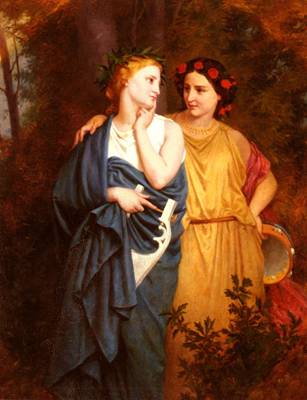
Summaries and interpretations of the ancient myths
Includes links to ancient sources
Return to CLA 1-216-97 home
Last updated 24 October 05
Includes links to ancient sources
Return to CLA 1-216-97 home
Last updated 24 October 05

"The Banquet of Tererus", by Peter Paul Rubens
In Rueben's painting one can easily see that Philomela and Procne are rushing to Tereus to show him the head of his son. When looking carefully, we see the anguish on Tereus' face and the passionate stances the women take. The female on the right is holding either a torch or staff weapon and Tereus is grasping a sword set behind him. In the background one can see a small figure opening the door to this room, the figure is in shadow and so, cannot be identified.
Peter Paul Rubens was a baroque painter born in 1577. He was the most respected northern European artist of his day. His Calvinist father fled to Germany to escape religious persecution, but after his death the Rubens family moved back to Antwerp Here, Peter was raised as a Roman Catholic and received early training as an artist and a courtier. "By the age of 21 he was a master painter whose aesthetic and religious outlook led him to look to Italy as the place to complete his education. During the final decade of his life, Rubens turned more and more to portraits, genre scenes, and landscapes.These later works lack the turbulent drama of his earlier paintings but reflect a masterful command of detail and an unflagging technical skill. Despite recurring attacks of arthritis, he remained an unusually prolific artist throughout his last years."
Matthew Arnold's "Philomela" (1822-1888)
In Matthew Arnold’s Philomela, he speaks about how Philomela felt about all that happened to her as a result of Tereus chasing her. She is in pain, she feels betrayed. Tereus claimed to love her, claimed that her sister was dead, and then it turned out that he was a liar. Philomela was worried about her sister and had to escape from where Tereus was keeping her in the “Thracian wild.” Philomela can never tell if her heart will heal, but when she turns into a nightingale, her worries are no more. She is better.
Matthew Arnold was born on December 24, 1822. He was the son of Thomas and Mary Arnold, and married to Frances Lucy Arnold from 1851. He attended Balliol College at Oxford from 1841-1844. He wrote many poems such as “Philomela” and “Dover Beach.” He was a school inspector from 1851 to 1883 and a Professor from 1857 to 1867. He died of heart disease on April 15, 1888
Sir Philip Sidney's 91. "Philomela" from The Oxford Book of English (Arthur Quiller-Couch, ed. 1919)Verse: 1250–1900.
In this poem the speaker compares Philomela to a bird in spring who is singing out her woes. As the poems continues the speaker tells Philomela that the force Tereus used against her is less than the pain and saddness they are feeling. The speaker says Tereus' love is the only source of pain for Philomela. For this love the speaker is "daily craving" so they tell Philomela to be glad becuase she has someone who loves her. (line 17)
Sidney was born in 1554, at Penshurst, Kent. After private schooling, he entered the Shrewsbury School at the age of ten in 1564. After attending the Christ Church in Oxford, he left without earning a degree in order to complete his education by travelling the European continent. Sidney returned to England in 1575, living the life of a popular and eminent courtier in the queen's court. Sidney died of an unhealed musket wound to the leg at about thirty-two years of age.
In this painting by Jane Gardner Bouguereau depicts Procne and Philomela embracing each other as sisters and best friends. They each are holding a musical instrument, one a lyre and the other a tambourine. It is not clear which sister is which. The setting of the scene seems to be out doors because we can see shrubs and trees in the background. Each of them has wreaths in their hair and wear solid color tunics. It is not clear whether this picture is before or after Philomela has her tongue cut out, but the sisters look happy in the painting.
Jane Gardner Bouguereau is one of the first American women artists who dared to invade the all male establishment of the French art academies. Born in Exeter, New Hampshire, Gardner graduated in 1856 from Lasell Seminary in Auburndale, Mass. Gardner became an accomplished painter, the first American woman to exhibit in the Paris Salon, in 1866, and the first to win a gold medal (from her painting, Impudence in 1877). Her studio on the Rue Notre Dame des Champs became a mecca for visiting Americans traveling abroad.
"The Love of the Nightengale" a play by Timberlake Wertenbaker
The performance of the play takes place in a minimalist stage and costuming. Drums supply the music for the play and introduce the beginning of the play. The play begins with a narrator that introduces the setting with the chorus of five male members act out scenes and tells the audience about the Athenian war. Procne and Philomela enter the scene and discuss Procne's wedding. The next scene includes the wedding of Procne to Tereus. Procne expresses her longing for her sister, and Tereus obliges and goes to retrieve her, falling madly in love with her.

Tereus brings Philomela back, rapes her, and cuts out her tongue. After he imprisons her, he tells Procne that Philomela is dead. After many years Philomela is able to communicate with her sister of her story through a play. On their reuniting they come up with a plan to get back at Tereus. They kill Procne's son and feed him to Tereus. The chorus then tells the audience of Philomela, Procne, and Tereus' fate.
